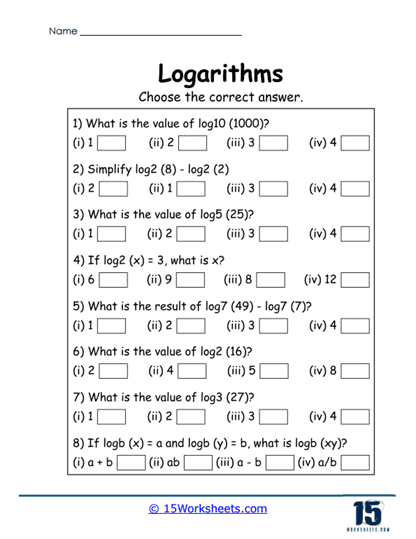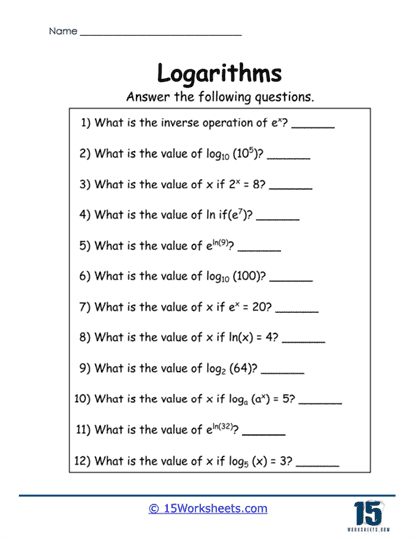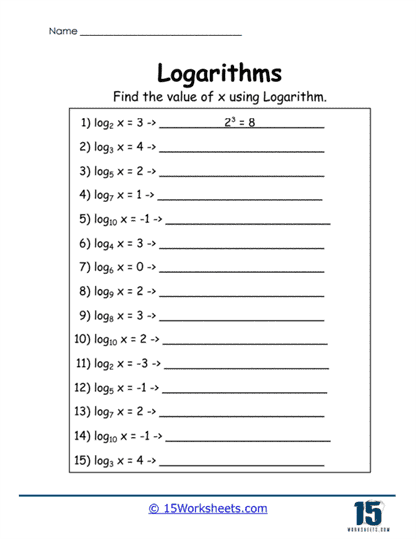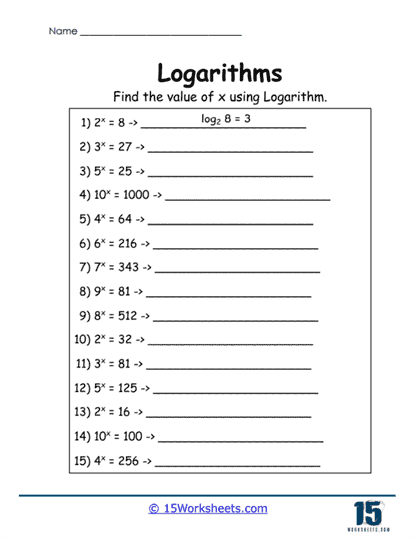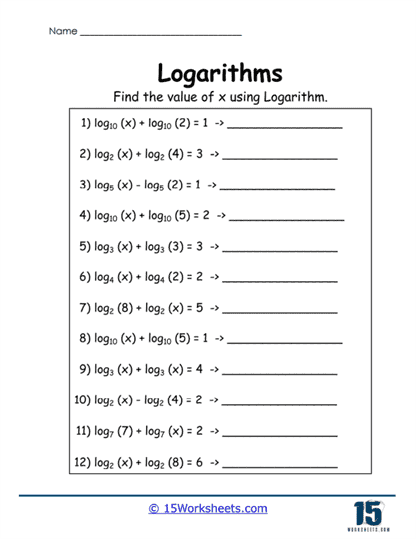Logarithms Worksheets
All About These 15 Worksheets
This collection of logarithm worksheets is designed to provide comprehensive and engaging practice for students at various learning levels. Whether you are a teacher, homeschooler, or student looking to strengthen your understanding of logarithmic concepts, these worksheets offer a structured and accessible format to achieve mastery. Available in convenient PDF format, these worksheets are easy to view, download, and print, making them perfect for in-class activities, homework assignments, or self-study sessions at home.
The worksheets in this collection cover a broad range of logarithmic topics, from basic logarithmic evaluations to more complex algebraic manipulations involving logarithmic expressions. They are particularly suited for students in algebra and pre-calculus courses, though advanced learners can also benefit from the detailed exercises provided. Each worksheet focuses on specific logarithmic concepts, helping students practice and solidify their understanding incrementally.
Key Features and Benefits
1. Basic Logarithmic Evaluation
The first set of worksheets (as illustrated in the first few pages) focuses on evaluating basic base-10 logarithms. These problems are designed to build a strong foundation by encouraging students to calculate common logarithms such as log10 10, log10 1, log10 100 and more. These fundamental exercises are critical for understanding how logarithms work in various applications and prepare students for more challenging logarithmic equations.
2. Logarithmic Expressions with Various Bases
Another section focuses on evaluating logarithms with different bases, such as log2, log3, log4, and others. Students practice calculating logarithms for specific numbers like 8, 27, 81, 64, and 125, using different logarithmic bases. This variety allows students to become adept at working with logarithms beyond base 10, which is especially important for higher-level math courses like calculus.
3. Conversion Between Exponential and Logarithmic Forms
Students will also find exercises that guide them in converting between exponential and logarithmic forms, such as converting 23 = 8 into log2 8 = 3. This conversion is a key skill in algebra, helping learners understand the relationship between exponents and logarithms. These worksheets progressively build this skill by presenting various equations that students must convert into logarithmic form, enhancing their comprehension of inverse relationships.
4. Applying Logarithmic Rules
The collection includes worksheets that focus on applying logarithmic rules, such as the Product Rule, Quotient Rule, and Power Rule. These rules are essential for simplifying complex logarithmic expressions and are commonly used in solving more advanced algebra problems. For instance, students may encounter problems like log2 (4 x 8), which can be simplified using the product rule. Each problem is designed to reinforce the application of these rules, ensuring students gain confidence in their abilities.
5. Simplification of Logarithmic Expressions
Another key aspect of this collection is the simplification of logarithmic expressions using algebraic properties. Worksheets provide opportunities to simplify expressions such as log (x2 x y2) or log3 (a4 x b3). These problems not only teach students how to manipulate logarithmic terms but also demonstrate the broader algebraic relationships that logarithms are part of.
6. Solving for Variables Using Logarithms
In addition to evaluating and simplifying logarithmic expressions, students are given opportunities to solve for variables within logarithmic equations. Problems like log2 x = 3 require students to think critically and reverse-engineer logarithmic equations to find the value of x. These problems are crucial for students to develop problem-solving skills that extend beyond routine calculations.
7. Multiple-Choice and Short Answer
To test comprehension and provide varied question formats, some worksheets include multiple-choice questions alongside short-answer problems. This variety ensures students can practice logarithmic concepts in multiple contexts, improving both accuracy and speed. The multiple-choice format can be especially useful for preparing for exams, while short-answer questions foster deeper thinking.
8. Challenging Problems
For more advanced learners, the collection features challenging logarithmic problems that require multi-step solutions. These problems incorporate a mix of logarithmic rules and ask students to apply their knowledge creatively to find solutions. For instance, simplifying expressions involving multiple logarithms or solving logarithmic equations involving exponents pushes students to engage with higher-level critical thinking and problem-solving strategies.
Real-world applications of logarithms could be featured in word problems, requiring students to apply logarithmic concepts to practical scenarios. These worksheets would help bridge the gap between theoretical knowledge and real-world problem-solving. Since logarithms are often used to describe exponential growth and decay (e.g., in population growth or radioactive decay), worksheets focusing on these applications would add relevance to the learning process. Students would work through problems involving exponential functions and then apply logarithms to solve them.
These logarithmic worksheets are designed to guide students from basic to advanced concepts, providing a step-by-step progression that encourages confidence and competence. For teachers, the collection offers a ready-made resource to assign homework or in-class practice, saving time and ensuring comprehensive coverage of logarithmic topics. Homeschoolers will also appreciate the clear layout and structured format that makes self-guided learning manageable.
The fact that these worksheets are available in PDF format ensures that they are easy to download, print, and distribute, making them accessible to students regardless of their learning environment. Whether students are in the classroom or learning remotely, these worksheets provide the necessary practice to master logarithms.
What Are Logarithms?
At its core, a logarithm is a mathematical concept that helps us solve equations involving exponents. A logarithm answers the question: “To what exponent do I need to raise a given base to get a certain number?” For instance, if we have 23, the logarithmic equivalent would be log2 (8) = 3. In this case, the logarithm tells us that we need to raise 2 to the power of 3 to get 8. The general form of a logarithm is written as:
logb(y) = x
This means that bx = y, where b is the base, x is the exponent, and y is the result. Logarithms can have different bases, but the most common ones are base 10 (called the common logarithm) and base e (called the natural logarithm, where e is approximately 2.718). The logarithmic function is the inverse of the exponential function, making it a useful tool for dealing with exponential growth and decay.
How Logarithms Are Used in the Real World
Logarithms are not just abstract mathematical tools confined to textbooks; they are essential in a wide range of real-world applications across science, technology, and finance. These applications often involve situations where things grow or shrink exponentially or where large scales need to be compressed into manageable numbers. Understanding logarithms allows us to make sense of these complex processes by translating exponential relationships into simpler terms.
One of the most well-known real-world uses of logarithms is in the Richter scale, which measures the magnitude of earthquakes. The scale is logarithmic, meaning that each whole number increase represents a tenfold increase in the strength of the earthquake. For instance, an earthquake with a magnitude of 6 on the Richter scale is ten times stronger than an earthquake with a magnitude of 5. This logarithmic scale helps scientists and the general public comprehend the vast differences in the energy released by earthquakes. Without logarithms, it would be extremely difficult to express and compare the severity of different earthquakes, especially since the actual energy release can vary by orders of magnitude.
Similarly, logarithms are used to measure sound intensity on the decibel (dB) scale. The decibel scale is also logarithmic, which means that a small change in decibels corresponds to a significant change in the intensity of sound. For example, a 10 dB increase translates to a tenfold increase in sound intensity. This is why a concert or a noisy traffic jam can seem much louder than everyday background noise, even if the decibel readings are only slightly higher. Logarithms allow sound engineers and audiologists to measure, compare, and manage sound levels in a way that reflects how humans perceive changes in loudness.
Logarithms also play a key role in computer science, particularly in algorithms used for searching and sorting data. One of the most fundamental algorithms in this regard is the binary search, which operates with a time complexity of O(log n). This means that the time required to search through a dataset increases logarithmically as the size of the dataset grows. In simpler terms, even if you double the amount of data, the number of steps needed to find a specific piece of information only increases slightly. This efficiency is crucial in modern computing, where vast amounts of data must be processed quickly. Logarithmic growth ensures that searches and operations remain manageable even as data sets expand exponentially, such as in big data applications or internet searches.
In the realm of science and biology, logarithms are instrumental in understanding processes that involve exponential growth or decay, such as population growth and radioactive decay. For example, when studying the growth of a bacterial population, scientists use logarithms to make sense of how quickly the population increases. Bacteria multiply exponentially, meaning their population can double in a short amount of time. By using logarithmic models, scientists can predict the population size at different points in time, allowing them to study and manage the growth more effectively. Similarly, in nuclear physics, logarithms help model the decay of radioactive materials. The half-life of a substance, which indicates the time it takes for half of the substance to decay, is calculated using logarithmic functions, helping scientists understand the rate of decay and its implications for things like medical treatments or environmental safety.
Logarithms compress large, exponential numbers into more digestible forms, making them an invaluable tool for analyzing phenomena that would otherwise be difficult to comprehend on a linear scale. Whether measuring the magnitude of natural disasters, understanding how sound behaves, optimizing complex algorithms, or studying natural processes like growth and decay, logarithms serve as a bridge between exponential relationships and practical human understanding.



